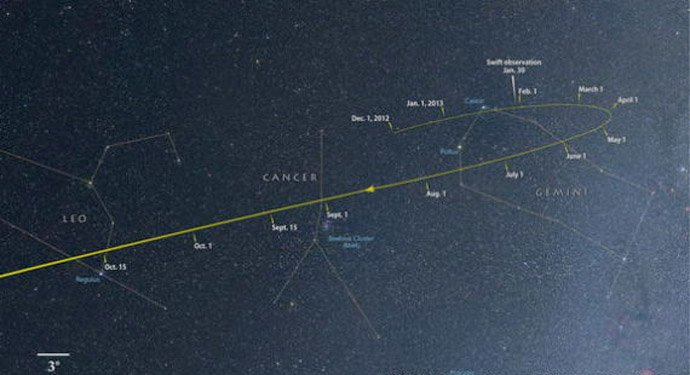
NASA spacecraft Swift has captured a photo of Comet ISON. The icy wanderer is expected to attract stargazers worldwide when it swings close to the sun later this year.
"Comet ISON has the potential to be among the brightest comets of the last 50 years, which gives us a rare opportunity to observe its changes in great detail and over an extended period," NASA’s official website quoted an astronomer with University of Maryland at College Park (UMCP), Dennis Bodewits, who helped obtain the new image.
The photo of Comet ISON was taken at the end of January, but NASA unveiled it two months later.
Comet ISON was first discovered in September 2012 by two Russian astronomers Vitali Nevski and Artyom Novichonokm who used the International Scientific Optical Network located near the city of Kislovodsk. The comet's official designation is Comet C/2012 S1.
By tracking the celestial body over the last two months when scanning for the most powerful explosions in the universe, Swift allowed astronomers to learn new details about how large the comet is and how fast it is spewing out gas and dust. SWIFT’s purpose was to determine how much ice is on the comet.
"Using images acquired over the last two months from Swift's Ultraviolet/Optical Telescope (UVOT), the team has made initial estimates of the comet's water and dust production and used them to infer the size of its icy nucleus," NASA officials wrote in a statement.
NASA’s image of the comet shows it as a bright and fuzzy white ball. On January 29, ISON was about 670 million kilometers away from Earth and 740 million kilometers from the sun.
Some scientists predict that ISON could be the "Comet of the Century" as it makes its closest approach to the sun in late November. But a recent analysis found that the comet is not brightening as expected.
"It looks promising, but that's all we can say for sure now. Past comets have failed to live up to expectations once they reached the inner solar system, and only observations over the next few months will improve our knowledge of how ISON will perform," an astronomer at Lowell Observatory and a member of the Swift team, Matthew Knight, told NASA.
As NASA officials have explained, all comets are made of dust and frozen gases that mix together to form a sort of "dirty snowball" in space. Water ice in comets typically stays frozen until the comet approaches within three times the Earth's distance to the sun, at which time the water ice heats up and changes directly into gas (a process called sublimation), creating jets of material that can make the comet brighter.
Swift's observations revealed that Comet ISON is currently spilling about 51 tons of dust and only about 60 kilos of water every minute. The difference suggests that the comet is still too far away from the sun in order to show its full potential, scientists explain.
The main question: whether Comet ISON will live up to its celestial hype or fizzle out in a whimper? The answer is not yet known, but astronomers say it will become clear in the next few months.
On the first day of October 2013 the comet will pass within 10.8 million kilometers of Mars, and may be spotted by orbiters around the Red Planet.
On November 28 — 58 days after swinging by Mars — Comet ISON will make its closest approach to the sun, flying within 1.2 million kilometers of the star's surface. Several sun-watching observatories will be tracking the comet at that time, and ISON may even become visible to the naked eye in the daytime sky, NASA officials claimed.
The comet will make its closest approach to Earth on December 26, coming with 64.2 million kilometers of the planet.
Comet Hale–Bopp (C/1995 O1) was one of the most widely observed comet of the 20th century and one of the brightest seen for many decades. It was visible to the naked eye for a record 18 months, twice as long as the previous record holder, the Great Comet of 1811.

Copyright 2013 mojeNovosti.com
web developer: BTGcms